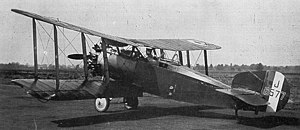Westland Weasel
| Weasel | |
|---|---|

| |
| Role | Fighter
|
| National origin | United Kingdom |
| Manufacturer | Westland Aircraft |
| First flight | November 1918 |
| Retired | 1925 |
| Status | Prototype |
| Number built | 4 |
The Westland Weasel was a prototype British two-seat fighter/reconnaissance aircraft of the First World War. Designed to replace the Bristol Fighter, the Weasel was a single engined tractor biplane. Four prototypes were built, but no production followed owing to the failure of its original engine, although the prototypes were used as engine test beds for the successful Armstrong Siddeley Jaguar and Bristol Jupiter engines.
Development and design
The Westland Weasel was designed by
The first prototype, although largely complete by the end of June,
Despite this, an order was placed for a fourth prototype to serve as an engine testbed. The first and third prototypes were fitted with the Armstrong Siddeley Jaguar radial, while the second and fourth aircraft were fitted with the Bristol Jupiter engine.[6] These aircraft proved valuable testbeds, with the last Weasel remaining in use until May 1925.[7]
Specifications (Dragonfly engine)
Data from War Planes of the First World War: Volume Three [7]
General characteristics
- Crew: 2
- Length: 24 ft 10 in (7.57 m)
- Wingspan: 35 ft 6 in (10.82 m)
- Height: 10 ft 1 in (3.07 m)
- Wing area: 368 sq ft (34.2 m2)
- Empty weight: 1,867 lb (847 kg)
- Powerplant: 1 × ABC Dragonfly I9-cylinder air-cooled radial piston engine, 320 hp (240 kW)
- Propellers: 2-bladed fixed-pitch propeller
Performance
- Maximum speed: 131 mph (211 km/h, 114 kn) 65,000 ft (19,812 m)
- Service ceiling: 20,700 ft (6,300 m)
- Time to altitude: 15,000 ft (4,572 m) in 19 minutes
- Wing loading: 8.35 lb/sq ft (40.8 kg/m2)
- Power/mass: 0.10 hp/lb (0.16 kW/kg)
Armament
- Guns: 2x forward firing, synchronised .303 in Vickers machine guns and 1 or 2× Lewis guns on Scarff ring in rear cockpit
See also
Aircraft of comparable role, configuration, and era
References
- Bruce, J.M. War Planes of the First World War: Volume Three Fighters. London:Macdonald, 1969. ISBN 0-356-01490-8.
- James, Derek N. Westland Aircraft since 1915. London:Putnam, 1991. ISBN 0-85177-847-X.
External links
- Aircraft Data Sheet: Weasel (1918). AgustaWestland.
